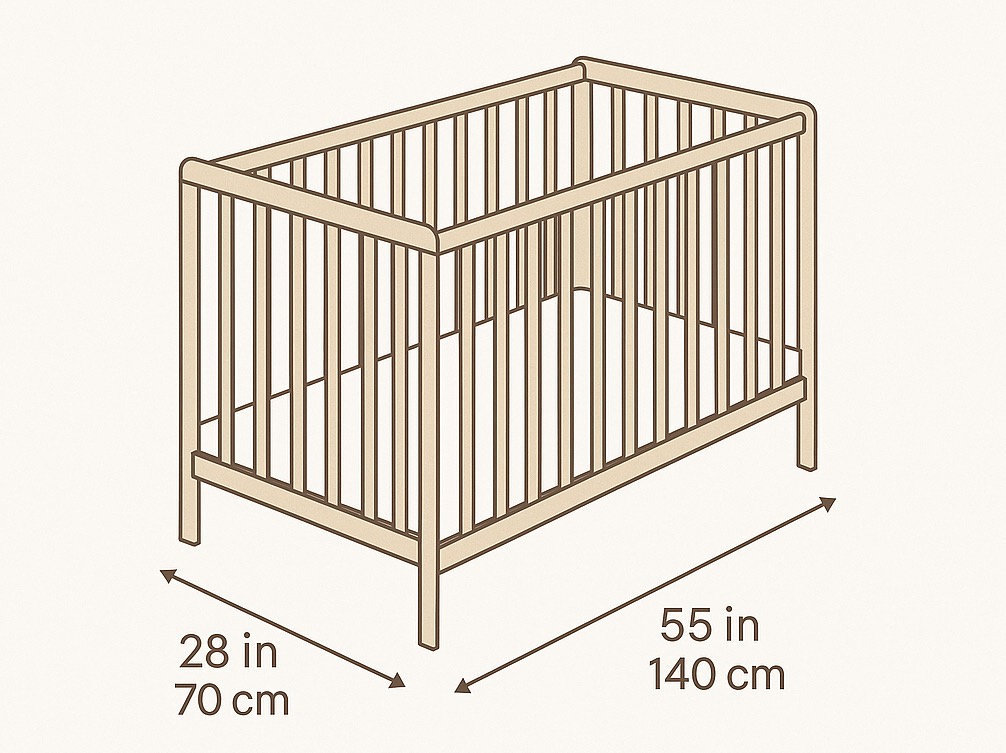Cot – The Bed That Grows with Your Baby
Is your baby outgrowing the crib, but not quite ready for a big kid bed? A cot bed is the perfect in-between solution—designed for safety, comfort, and long-term value. Whether you’re furnishing a nursery or planning ahead for toddlerhood, this guide will walk you through everything you need to know about cot bed sizes, features, pros and cons, and how to shop wisely.

📏 Cot Bed Dimensions
| Region | Cot Bed Mattress Size | Frame Size (approx.) |
|---|---|---|
| UK & Europe | 27.5″ × 55″ (70 × 140 cm) | 75–77 cm × 144–147 cm |
| Australia | 27.5″ × 55″ (70 × 140 cm) | Similar to UK sizing |
| US | Not common (cribs used instead) |
👶 Who are cots best for?
Babies and Toddlers (approx. 6 months to 5 years old).
Parents looking for a longer-term sleep solution beyond the crib.
Families with limited space, who want to avoid buying multiple beds in early childhood.
✅ Pros of cot bed
🛠️Convertible Design:
Transforms from a baby cot to a toddler bed.
💸Cost-Effective:
One bed from infancy to around age 5.
✅Safe and Secure:
High sides protect infants, while low height helps toddlers.
🎨Stylish Options:
Modern, classic, and themed designs available.
📏Standard Mattress Size (in some markets):
Easier to find bedding in the UK and Australia.
❌ Cons of cot bed
🇺🇸Not Widely Used in the U.S.:
Most American parents use a crib, then switch to a junior bed or twin bed.
📐Can Be Bulky: Slightly larger than a standard crib.
🔨Some Assembly Required: Particularly with convertible models.
🛏️Mattress May Need Replacing:
Especially if used heavily from infant through toddler stages.
🏠 Room space needed
Recommended Space: At least 6.5 ft × 5 ft (2 m × 1.5 m) to allow for clearance and movement.
Works well in nurseries, shared rooms, or compact bedrooms.
🕰️ History & Fun Facts
Evolved from traditional cribs:
The cot bed became popular in the UK and Europe as a transitional sleep solution.
“Cot” vs “Crib”:
In the UK, “cot” refers to what Americans call a “crib.” A “cot bed” is essentially a convertible crib-toddler bed combo, but often a bit larger.
Popular in eco-conscious circles:
Due to reduced waste and fewer purchases, cot beds are often favored by sustainability-minded parents.
Some models extend further:
A few luxury or Scandinavian designs convert into full junior beds or sofas.
🛒 Cot Bed Shopping Guide
🧩 What to Look For
- Convertible Feature: Can the sides be removed or the bed extended?
- Adjustable Mattress Heights: Ideal for newborns and older babies.
- Build Quality: Solid wood or high-quality MDF preferred.
- Finish and Materials: Non-toxic, BPA-free, GREENGUARD-certified options.
- Slat Spacing and Standards: Ensure it meets BS EN 716 (UK) or AS/NZS 2172 (Australia).
🏷️ Mattress Tips
- Size: Standard cot bed mattresses are 70 × 140 cm.
- Firmness: Babies need a firm mattress for safety; toddlers may prefer something slightly softer.
- Breathability: Look for vented or dual-sided designs.
🛍️ Where to Shop
- UK: John Lewis, Mamas & Papas, IKEA, Mothercare (if available)
- Australia: Baby Bunting, Mocka, Boori, IKEA
- Online: Amazon UK, Wayfair, or eco-brands like Snüz or Stokke
🧠 Pro Tips
📏 Measure Your Room First:
Cot beds are larger than cribs.
🔄 Choose a Style That Ages Well:
Avoid overly babyish themes if you want it to last 4–5 years.
🛠️ Check Conversion Kits:
Some cot beds need separate kits for toddler conversion.
🧽 Easy-to-Clean Materials:
Accidents happen—water-resistant mattresses and washable covers are essential.
🌱 Go Sustainable:
Look for FSC-certified wood and organic bedding options.